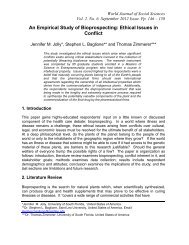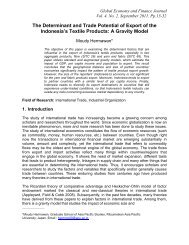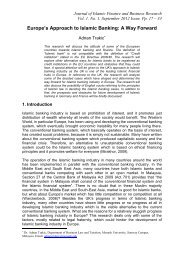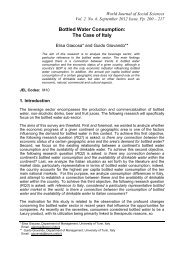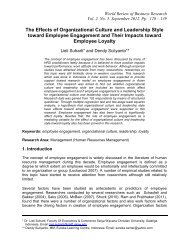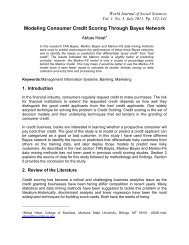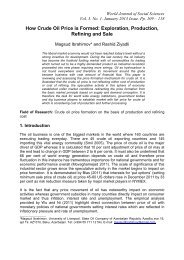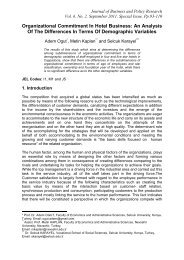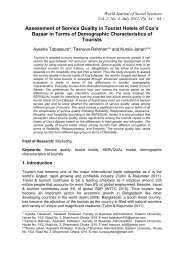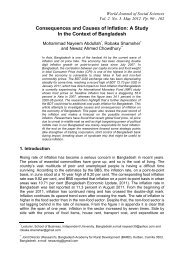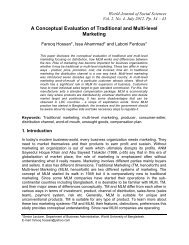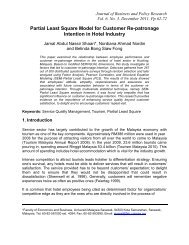Celebrity Advertising: Literature Review and Propositions - Wbiaus.org
Celebrity Advertising: Literature Review and Propositions - Wbiaus.org
Celebrity Advertising: Literature Review and Propositions - Wbiaus.org
Create successful ePaper yourself
Turn your PDF publications into a flip-book with our unique Google optimized e-Paper software.
World <strong>Review</strong> of Business Research<br />
Vol. 2. No. 4. July 2012. Pp. 24 – 36<br />
<strong>Celebrity</strong> <strong>Advertising</strong>: <strong>Literature</strong> <strong>Review</strong> <strong>and</strong> <strong>Propositions</strong><br />
Peter Yannopoulos*<br />
In this paper I review several studies in the area of celebrity advertising.<br />
Topics reviewed include, why companies use celebrity advertising, the<br />
importance of achieving the right fit between the br<strong>and</strong> <strong>and</strong> the celebrity,<br />
the use of athletes as spokespeople, some financial considerations of<br />
celebrity advertising, <strong>and</strong>, finally, potential risks of celebrity advertising.<br />
Next, I develop several propositions based on the discussion of papers in<br />
the area of celebrity advertising by various authors as reviewed in this<br />
paper. The last section includes several conclusions <strong>and</strong> the managerial<br />
implications of the research.<br />
Field of Research: <strong>Celebrity</strong> advertising, <strong>Celebrity</strong> endorsersement, Sponsorship,<br />
<strong>Celebrity</strong> spokespeople<br />
1. Introduction<br />
A celebrity endorser is “an individual who is known to the public (actor, sports figure,<br />
entertainer, etc) for his or her achievements in areas other than that of the product class<br />
endorsed” (Friedman & Friedman 1979). Sponsorship, on the other h<strong>and</strong>, is defined as<br />
“providing support for <strong>and</strong> associating the <strong>org</strong>anization’s name with events, programs, or<br />
even people such as athletes or teams” (Peter & Donnelly 2006). Corporations chose<br />
both sponsorship <strong>and</strong> celebrity endorsement as means to increase exposure <strong>and</strong> br<strong>and</strong><br />
awareness, as well as reposition their products. The terms celebrity endorsement <strong>and</strong><br />
sponsorship will be used interchangeably in this article.<br />
The percentage of spending on celebrity advertising has increased in recent years. It<br />
has been estimated that about 10% of the dollars spent on television advertising are<br />
used in celebrity endorsement advertisements (Agrawal & Kamakura 1995). Because of<br />
its importance, it is imperative for managers to be able to determine what impact a<br />
particular celebrity endorsement will have on different aspects of a br<strong>and</strong>’s performance<br />
such as br<strong>and</strong> preference, br<strong>and</strong> loyalty, <strong>and</strong>, ultimately, sales <strong>and</strong> profitability (Aaker<br />
1991; Keller 2008).<br />
In this paper I review selected aspects of research on celebrity advertising, discuss the<br />
reasons firms use celebrity advertising, <strong>and</strong> examine how to determine the appropriate<br />
fit between spokesperson <strong>and</strong> product, as well as the employment of athletes. In<br />
addition to examining these relationships <strong>and</strong> offering explanations, I analyze the risks<br />
associated when using celebrity endorsers, such as poor athletic performance <strong>and</strong><br />
sc<strong>and</strong>als, <strong>and</strong> how this impacts shareholders for the sponsor firm. Finally, I offer a<br />
number of propositions <strong>and</strong> discuss the conclusions <strong>and</strong> managerial implications arising<br />
from the article.<br />
_________________________<br />
*Dr. Peter Yannopoulos, Brock University, Canada, email: pyannopoulos@brocku.ca
2. Why Use <strong>Celebrity</strong> <strong>Advertising</strong><br />
Yannopoulos<br />
<strong>Celebrity</strong> endorsement advertising has been recognized as a “ubiquitous feature of<br />
modern day marketing” (McCracken 1989; Keller 2008). Furthermore, celebrity<br />
endorsement activity has been increasing over the past years (Biswas, Hussain &<br />
O’Donnell 2009). From 1984 to 1999, there was a reported eleven-fold increase in<br />
sponsorship spending, representing $23.16 billion or 7.0% of the worldwide advertising<br />
budget (Meenaghen 2001; Pope, Voges & Brown 2009). Some estimates suggest that<br />
one quarter of all commercials screened in the United States include celebrity endorsers<br />
(Till & Shimp 1998). Athletes, both amateur <strong>and</strong> professional, as well as musicians,<br />
television <strong>and</strong> movie stars, <strong>and</strong> even animated spokescharacters, such as Mickey<br />
Mouse, are used to promote <strong>and</strong> bring awareness to products <strong>and</strong> services through<br />
sponsorship campaigns.<br />
The main goal of using celebrities in advertising is to generate publicity <strong>and</strong> attention to<br />
the br<strong>and</strong> (Biswas, Hussain & O’Donnell 2009) as well as influence consumer<br />
perceptions of the br<strong>and</strong> stemming from their knowledge of the celebrity (Keller 2008).<br />
This requires that the celebrity must be well known in order to have the desired effect<br />
(Keller 2008). Kaikati (1987) expressed five advantages to employing celebrities to<br />
endorse products: drawing attention, crisis management, br<strong>and</strong> repositioning, global<br />
marketing, <strong>and</strong> boosting sales. Biswas et al. (2009) found that the reasons for recalling<br />
celebrities included, popularity, status symbol, attractiveness <strong>and</strong> glamour, likeability<br />
<strong>and</strong> recall value or familiarity of the celebrities. The increased awareness <strong>and</strong> attention<br />
resulting from celebrity advertising is thought to combat the challenge of advertising<br />
clutter <strong>and</strong> bring instant credibility <strong>and</strong> br<strong>and</strong> recall to consumers. Pope, Voges <strong>and</strong><br />
Brown (2009) found that sponsorship positively affects an individual’s perception of a<br />
br<strong>and</strong>’s quality <strong>and</strong> image. Products that may be of inferior quality to their competitors,<br />
or have fewer features can benefit from using a high profile celebrity to pitch them to<br />
consumers.<br />
The target market of campaigns must be considered when selecting spokespeople <strong>and</strong><br />
whether a celebrity is the best medium to reach them with. Biswas et al. (2009) found<br />
that people aged 18-25 have the greatest ability to recall br<strong>and</strong>s as a result of celebrity<br />
advertising compared with older age groups. The main reason for this result is that the<br />
older age group is looking for greater product information in advertisements, whereas<br />
celebrity campaigns focus on the feelings <strong>and</strong> perception of the consumer. In addition,<br />
the placement of celebrity advertisements in sites like youtube.com or metacafe.com,<br />
where most viewers are relatively younger, information rich, <strong>and</strong> Internet savvy,<br />
suggests that celebrity-based advertisements are no longer limited to traditional<br />
campaign media (Biswas et al. 2009). This helps overcome the problem that the<br />
younger age groups typically change channels during television commercials or use<br />
disruptive technologies such as TiVo <strong>and</strong> DVR to bypass commercials (Biswas et al.<br />
2009).<br />
Different cultures react differently to the use of celebrity spokespeople. Developing<br />
economies, such as that of India, have vastly different dimensions of culture as outlined<br />
by Hofstede (1997). Using Hofstede’s framework, Biswas et al. (2009) suggest that due<br />
25
Yannopoulos<br />
to a high power-distance relationship within India’s culture, there is a vast gap in<br />
lifestyles between consumers <strong>and</strong> celebrities. Due to the extreme differences in lifestyle<br />
between consumers <strong>and</strong> celebrities, the majority of respondents in the Biswas et al.<br />
(2009) research did not believe that celebrities use in advertising campaigns actually<br />
use the products they were promoting. However, there is very high br<strong>and</strong> recollection<br />
between the celebrity <strong>and</strong> the product.<br />
While the future of celebrity spokespeople in India remains promising, recent findings<br />
suggest that celebrity spokespeople are not as effective as they once were in developed<br />
markets such as the United States (Biswas et al. 2009). Furthermore, the number of<br />
products a celebrity endorses negatively influences consumer perceptions of endorser<br />
credibility <strong>and</strong> likeability, as well as the attitude toward the ad (Tripp, Jensen & Carlson<br />
1994). Also, the frequency of exposure of the ad has a negative impact on purchase<br />
intention due to over-exposure. Monitoring frequency of use is the most critical success<br />
factor in implementing an ad campaign involving sponsorship or celebrity spokespeople<br />
(Pope et al. 2009).<br />
One successful campaign that overcame these over-exposure challenges was the “Got<br />
Milk? – Moustache” campaign, which showcased a different celebrity each month. Hsu<br />
<strong>and</strong> McDonald (2002) found that endorsing a product with multiple celebrities is an<br />
effective strategy for appealing to various audiences to which the product is aimed. The<br />
use of multiple-celebrities avoided the problem of over-exposure, while the usage of the<br />
product was believable, which led to greater acceptance by consumers. The campaign<br />
also received external press as speculation arose as to which celebrity would be<br />
featured next.<br />
3. Achieving the Right Fit between the Br<strong>and</strong> <strong>and</strong> the Endorser<br />
Using celebrity endorsement in advertising campaigns varies depending on the type of<br />
product involved. Furthermore, the type of celebrity is equally important <strong>and</strong> varies<br />
based on the goals of the campaign <strong>and</strong> target audience. While visual cues <strong>and</strong> soft sell<br />
work for glamour-related products <strong>and</strong> low involvement products such as sodas, high<br />
involvement products such as consumer durables warrant more product information<br />
(Biswas et al. 2009). Celebrities that are known from television or movie roles can<br />
maximize the attributes of their portrayed characters to promote products that otherwise<br />
would not have any role in their everyday life. The reason this is successful is due to<br />
consumers associating these celebrities with the character roles, creating a level of<br />
believability that would otherwise not exist. Athletes or other celebrities such as authors<br />
or public figures are not always able to leverage this created character to maximize their<br />
endorsements.<br />
The importance of fit between endorser <strong>and</strong> product is known as the “match-up<br />
hypothesis” (Till & Busler 1998). The match-up hypothesis suggests that endorsers are<br />
more effective when there is a "fit" between the endorser <strong>and</strong> the endorsed product.<br />
This congruence between endorser <strong>and</strong> message leads to greater believability <strong>and</strong><br />
acceptance by the end-user, making the endorsement more trustworthy. The image of<br />
the celebrity needs to match that of the product for increasing believability <strong>and</strong> building<br />
26
Yannopoulos<br />
credibility, thus, validating the match-up hypothesis (Biswas et al. 2009). The kinds of<br />
products that are congruent with celebrity endorsements include cosmetics, fashion<br />
products, sports products, cars, credit cards <strong>and</strong> mutual fund products. (Biswas et al.<br />
2009)<br />
Kelman (1961) suggests that celebrity endorsement is successful due to two social<br />
processes. The first is identification, suggesting that consumers conform to the<br />
behaviours <strong>and</strong> recommendations of celebrities because they derive satisfaction from<br />
believing they are like these celebrities. The second social factor is internalization,<br />
suggesting that consumers conform to the attitudes or behaviours advocated by others<br />
because they believe in the substance of the new attitude or behaviour (Friedman &<br />
Friedman 1979). Identification is therefore linked to likability <strong>and</strong> attractiveness, while<br />
internalization is linked to the expert knowledge that an endorser possesses.<br />
Following Kelman’s (1961) classification of endorsements, Friedman <strong>and</strong> Friedman<br />
(1979) argue that there are two major types of endorsements. The first type of<br />
endorsement uses attractiveness <strong>and</strong> the identification process to promote a product.<br />
These are best suited for low involvement purchases. The other type of endorsement<br />
involves the use of expert knowledge <strong>and</strong> the internalization process. This is best used<br />
for high involvement purchases. Endorsers such as Michael Jordan, who is an attractive<br />
endorser, are more effective when endorsing products related to his athletic prowess<br />
such as Nike or Gatorade, rather than products that are unrelated to athletic<br />
performance such as WorldCom communications (Till & Busler 1998). However, an<br />
endorser can be involved in both low involvement product campaigns <strong>and</strong> high<br />
involvement product campaigns simultaneously for different products. An example of<br />
this is Olympic swimmer Michael Phelps, who endorsed low involvement purchases at<br />
the s<strong>and</strong>wich franchise Subway as well as high involvement purchases in thous<strong>and</strong><br />
dollar watches from Omega.<br />
Till <strong>and</strong> Busler (1998) found that the celebrity’s expertise in an area was more effective<br />
than their attractiveness when promoting a product or service. They suggest that when<br />
advertising high involvement purchases, such as automobiles, using a recognized race<br />
car driver would be more effective than using an attractive model. This is due to expert<br />
knowledge <strong>and</strong> trustworthiness demonstrated by the race car driver, as opposed to<br />
solely fulfilling social st<strong>and</strong>ing by purchasing the automobile. Interestingly, this varies<br />
depending on the positioning <strong>and</strong> target market of the product, such as if it is used as a<br />
status symbol, as opposed to high performance automobile.<br />
The type of endorser used should reflect the consumer risk associated with purchase of<br />
the product. For example, if a consumer is purchasing a complex product high in<br />
financial or performance risk, then an expert endorser should be used (Friedman &<br />
Friedman 1979). This brings greater product knowledge <strong>and</strong> believability to the<br />
advertisement <strong>and</strong> may help alleviate the potential for post-purchase cognitive<br />
dissonance. Other expert endorsers that have been successful are authors of topicspecific<br />
literature that provide a testimonial in print or commercial materials. For<br />
example, an author of a best-selling weight-loss cook book would provide expert<br />
knowledge <strong>and</strong> a greater level of believability if promoting a new frozen entree offering<br />
27
Yannopoulos<br />
from a grocery chain. While it is a low involvement purchase, the expert knowledge the<br />
author possess is more important than their personal attractiveness. If the product is<br />
used to address social or psychological needs of consumers, than celebrity<br />
endorsement would be best to address the identification social process (Friedman &<br />
Friedman 1979). This could include hair care products, cosmetics, <strong>and</strong> clothing to name<br />
a few.<br />
4. The Use of Athletes as Endorsers<br />
There comes a critical time when a marketing team must choose which celebrity or<br />
celebrities will endorse their product in an upcoming campaign. When using<br />
endorsement, there are typically three options. A celebrity (such as a well-known<br />
musician, actor, public figure, or author), an animated spokescharacter (for whom one<br />
would hold a trademark <strong>and</strong> can br<strong>and</strong> according to their product), or an athlete (be it<br />
professional or amateur sport). Athletes are becoming so well recognized for their<br />
endorsement deals, that many incorporate endorsements into their streams, providing<br />
marketers with a large number of willing <strong>and</strong> able potential endorsers (Charbonneau &<br />
Garl<strong>and</strong> 2005).<br />
Athletes, especially high performing <strong>and</strong> well-recognized ones, can be effective in<br />
creating br<strong>and</strong> awareness during a product launch. They can also be used to ‘cut<br />
through’, an act that is essential in today’s cluttered media environment (Charbonneau &<br />
Garl<strong>and</strong> 2005). Similar to celebrity endorsers, athletes as endorsers are most successful<br />
when the products they endorse are believable, <strong>and</strong> the athlete is sincere. Many<br />
researchers have found that athletes provide effective testimonials for products that<br />
have contributed to their own performance <strong>and</strong> success in their particular sport (Dyson<br />
& Turco 1997; Stone, Joseph & Jones 2003).<br />
Br<strong>and</strong> credibility is increased when the spokesperson has a higher likelihood of actually<br />
using the product. Within sports related products, believability is enhanced in ads with<br />
domain experts such as Michael Jordan endorsing Nike (Biswas et al. 2009). Biswas et<br />
al. (2009) recommend that if athletes are to be used, they have to be known for their<br />
achievement in their sports <strong>and</strong> be ranked in the top 1-2% of their field. The associated<br />
risk with this strategy relates to poor athletic performance <strong>and</strong> the perception that this<br />
may be linked to a specific product. For example, if a top athlete began endorsing a new<br />
sports drink, <strong>and</strong> by coincidence, their performance began to deteriorate within the<br />
same time period, a negative association with the product line may be inferred by those<br />
who closely follow the performance of this athlete.<br />
As noted earlier, testimonials from subject matter experts, such as authors, provide a<br />
level of believability that encourages the consumer to consider a product they may<br />
otherwise have not. The objective of using athletes as endorsers is to capture the<br />
attention of potential customers, strengthen recall of the br<strong>and</strong> name, reinforce the<br />
image of the product, give the message credibility, increase liking <strong>and</strong> recall of the ad,<br />
increase product attractiveness, <strong>and</strong> increase the likelihood of purchase (Burnett,<br />
Menon & Smart 1993; Thwaites 1995). Athlete endorsers are more persuasive when<br />
there is a close relationship between the endorsed product <strong>and</strong> the endorser, <strong>and</strong><br />
28
Yannopoulos<br />
greater congruence between the message conveyed by the celebrity image <strong>and</strong> the<br />
endorsed product (Yeung-Jo & June-Hee 2007).<br />
Sports team sponsorship should be primarily considered for successful teams only<br />
(Pope et al. 2009). However Pope et al. (2009) found that athletes can be successful<br />
product endorsers <strong>and</strong> elevate corporate image regardless of their athletic success at<br />
winning or losing, if the audience they are targeting are fans of the athletes who will<br />
support the campaign, win or lose. However, the same study revealed that corporate<br />
image <strong>and</strong> perception of br<strong>and</strong> quality decayed over a period of time as a team began to<br />
lose, when the audience were not fans or regular followers of the sport. When<br />
examining if a whole team should be used for endorsement as opposed to an individual<br />
athlete Pope et al. (2009) found that team performance as a whole creates strong<br />
associative linkages between team performance <strong>and</strong> br<strong>and</strong> quality. However, if an<br />
individual athlete is used, performance <strong>and</strong> br<strong>and</strong> quality are not as closely linked (Pope<br />
et al. 2009).<br />
There is very little research available on whether the sport itself that the athlete<br />
participates in has an effect on the effectiveness of a non-sporting product<br />
endorsement. An exception is Martin (1996) who raises the possibility that in addition to<br />
their own personality traits, athletes also bring to the endorsement process their<br />
particular sport's characteristics. The question is whether those characteristics that<br />
comprise the sport's image will affect consumer evaluations of the endorsement (Martin<br />
1996). This brings into question whether certain sports (such as golf or figure skating)<br />
would bring a higher perceived level of prestige or create a different evoked set than in<br />
other sports, such as football or hockey, which include more contact <strong>and</strong> roughness.<br />
There is definitely, a need for research in this area to answer this question <strong>and</strong> other<br />
similar questions.<br />
Regardless of sport, Shuart (2007) presented a unique way of examining athletes as<br />
endorsers that was contrary to most other researchers. He examined athletes as both<br />
celebrities <strong>and</strong> heroes by developing a matrix in which he classified athletes as either<br />
high or low in celebrity <strong>and</strong> hero status. For example, athletes such as O.J. Simpson<br />
<strong>and</strong> Dennis Rodman were depicted as high in celebrity but low in hero status. On the<br />
other h<strong>and</strong>, Michael Jordan <strong>and</strong> Magic Johnson were considered high in both celebrity<br />
<strong>and</strong> hero status. It is interesting that he classified Tiger Woods as high in both hero <strong>and</strong><br />
celebrity status, something that would not be true today. Shuart’s findings suggest that<br />
athletes can be both considered great athletes, as well as heroes, but the most<br />
successful endorsers, were those that were considered both. They were perceived as<br />
role models, <strong>and</strong> those that consumers aspired to be like. He depicted his findings<br />
through the creation of the <strong>Celebrity</strong>-Hero Matrix. The most successful endorsers were<br />
positioned in the upper right quadrant, whereas the least successful endorsers were in<br />
the lower-left quadrant.<br />
According to Shuart (2007), athletes who are positively perceived as heroes should be<br />
chosen as endorsers for consumer products over those with low hero, low celebrity<br />
measures. However, the decision which athlete to use within a specific quadrant can be<br />
quite difficult. Martin (1996) identified four key steps that must be systematically followed<br />
29
Yannopoulos<br />
in order to acquire the appropriate information required to identify the degree of fit<br />
between the sport, the athlete <strong>and</strong> the product. His critical steps are as follows:<br />
“(1) The image of the product must first be assessed. This is done through<br />
market research with consumers in which the factors that consumers think of<br />
when they think of the product are identified <strong>and</strong> measured.<br />
(2) The next stage of market research would go back to consumers with these<br />
image factors <strong>and</strong> measure the amount of these factors that are perceived to be<br />
in a variety of sports to determine the sport(s) with the closest fit to the product.<br />
(3) Athletes from the closest fitting sport(s) must be identified who have images<br />
that also closely fit the image of the product. At this stage the manager is looking<br />
for an athlete's image that will enhance the effect of the sport's image on the<br />
endorsement evaluation.<br />
(4) Consumers' evaluation of the endorsement by those athletes with the images<br />
that enhance the fit between the product image <strong>and</strong> the endorsement are then<br />
measured <strong>and</strong> the athlete accomplishing the greatest number of objectives would<br />
be selected.”<br />
Campaigns that have been implemented without following these, or similar, guidelines<br />
oftentimes come under scrutiny for not being believable, <strong>and</strong> therefore tarnish the image<br />
of the br<strong>and</strong>. Well-known examples include Olympic Athletes as endorsers for fast-food<br />
chains, such as McDonald’s. Canadian speed skater Cindy Klassen, <strong>and</strong> national team<br />
women’s hockey player Cassie Campbell were featured in a campaign run during the<br />
2010 Winter Olympics as mentioning that after difficult training sessions, they would go<br />
to McDonald’s for a meal. This campaign could have avoided this scrutiny had it<br />
followed step three of Martin’s four-step process. Neither their sports, nor the image of<br />
their sports were a fit with the product offering, <strong>and</strong> therefore the endorsement lacked<br />
credibility.<br />
Yeung-Jo <strong>and</strong> June-Hee (2007) found that the credibility <strong>and</strong> attractiveness of the<br />
celebrity athlete endorser depended on whether or not the athlete endorser was<br />
compatible with the endorsed product. As in the McDonald’s case above, the credibility<br />
of campaign was questioned due to an incompatibility with the endorsed product. Their<br />
research also suggests that in order to overcome a lower level of compatibility, athlete<br />
attractiveness may help bridge this gap.<br />
5. Potential Risks of <strong>Celebrity</strong> <strong>Advertising</strong><br />
There may be disadvantages to choosing celebrities as spokespeople instead of using<br />
commercial actors that are relatively unknown. Companies must be prepared to accept<br />
a certain amount of risk when associating with public figures <strong>and</strong> the impact this may<br />
have on their br<strong>and</strong> due to their relationship with them. Therefore, celebrities can<br />
successfully be leveraged to change consumers’ pre-existing perceptions of br<strong>and</strong><br />
30
Yannopoulos<br />
quality with the caveat that celebrity based advertising can negatively impact such<br />
assessments.<br />
Challenges when selecting an appropriate celebrity include other endorsement<br />
campaigns they are involved within. Overexposure by promoting diverse products<br />
weakens the relationship between a celebrity <strong>and</strong> a particular br<strong>and</strong>, thereby limiting the<br />
effectiveness of the campaign (Keller 2008). For example, Olympic swimmer Michael<br />
Phelps signed numerous endorsement deals following his medal haul at the 2008<br />
Beijing Olympics, which included br<strong>and</strong>s such as Subway, Speedo, Omega, AT&T,<br />
Powerbar, <strong>and</strong> Kellogg’s. Hein (2009) found that athletes such as LeBron James,<br />
Shaquille O’Neal <strong>and</strong> Reggie Bush have endorsed so many different companies that<br />
consumers get confused, <strong>and</strong> the endorsement means little.<br />
Another potential problem is that celebrities may draw attention to themselves <strong>and</strong> away<br />
from the br<strong>and</strong> as consumers may remember the celebrity but not the br<strong>and</strong>. Marketers<br />
must also consider the length of time the celebrity is expected to be relevant or in the<br />
limelight. Athletes recognized for winning Olympic medals lose their appeal as<br />
spokespeople after a period of time as they are no longer as relevant in the eyes of the<br />
consumer.<br />
In addition to risks of athlete performance, there is also the risk of when the athlete<br />
receives negative publicity (Erdogan & Kitchen 1998; Charbonneau & Garl<strong>and</strong> 2005).<br />
Some events involve incidents that change or damage the endorser’s reputation, wether<br />
innocent or not, but they can damage the reputation of the firm. These situations are<br />
referred to as negative events, <strong>and</strong> can range widely from accidents that hinder a<br />
celebrity’s ability to perform including career ending injuries, to exposure to substance<br />
abuse (Louie & Obermiller 2002) or could be as serious as criminal charges brought<br />
against a celebrity endorser.<br />
However, while most companies include clauses in celebrity contracts for termination on<br />
grounds of improper behavior, <strong>and</strong> take out insurance to cover the negative events<br />
relating to their celebrity endorsers, their image <strong>and</strong> reputation can still be tarnished<br />
simply by association. Pope et al. (2009) suggest that perceptions of br<strong>and</strong> quality may<br />
be affected by negative team performance, poor performance, or a negative event,<br />
however corporate image is not harmed. On the contrary, Goldsmith, Lafferty <strong>and</strong><br />
Newell (2000) found that endorser credibility had significant impact on corporate<br />
credibility, which directly affected purchase intention <strong>and</strong> acceptance of the br<strong>and</strong>.<br />
There does not appear to be a right or wrong way to deal with such incidents, however,<br />
research does suggest that the choice of endorsers from the early stages is critical in<br />
managing the reputation of the br<strong>and</strong> in the longer term. Consumers take the<br />
information they acquire from these advertising campaigns, <strong>and</strong> begin to make<br />
associations internally between endorsers <strong>and</strong> br<strong>and</strong>s. For example, a consumer may<br />
see an image of Michael Jordan, <strong>and</strong> the connections they begin to make are<br />
Basketball, Nike, Gatorade, Chicago Bulls, North Carolina, etc. This is considered the<br />
association set (Till <strong>and</strong> Shimp 1998). The more often the athlete is viewed, the more<br />
associations are created, with varying strength in ties. Till <strong>and</strong> Shimp (1998) found that if<br />
31
Yannopoulos<br />
the link between an endorser <strong>and</strong> br<strong>and</strong> is particularly strong (due to limited external<br />
links), then a negative event will subsequently lower br<strong>and</strong> evaluations. This strong<br />
effect was due to small association set sizes. As such, endorsers who are not well<br />
known, or who are associated with only one br<strong>and</strong>, will have a stronger negative impact<br />
to that one br<strong>and</strong>, than if they had been associated with numerous br<strong>and</strong>s, as the ties<br />
would have been weaker.<br />
In order to overcome these strong ties, Till <strong>and</strong> Shimp (1998) suggest that the consumer<br />
be educated with additional facts about the endorser, to create competition for<br />
associated links, <strong>and</strong> to slightly weaken the single tie between endorser <strong>and</strong> br<strong>and</strong> if it is<br />
deemed to be too strong. If the endorser or the br<strong>and</strong> had a large association set, with<br />
many links, then a negative event would not be as detrimental to the br<strong>and</strong>. For<br />
example, swimmer Michael Phelps was one of the most highly sought after<br />
spokespeople in the world <strong>and</strong> believed to have an earnings potential of up to $100<br />
million. He had sponsorship contracts with companies such as Speedo, Omega,<br />
Subway, <strong>and</strong> AT&T (Hein 2009). While a negative event did occur (in his case, an<br />
incident with drug usage), the associated set that consumers had with him was so<br />
strongly linked with Olympic medals, world champion, world record holder, <strong>and</strong><br />
swimmer, that the incident did not negatively impact br<strong>and</strong> perception of the products he<br />
endorsed, nor have a negative impact on consumer willingness to purchase. Phelps lost<br />
one sponsor in Kellogg, who felt his behaviour was not consistent with the company’s<br />
image (Hein 2009), while the rest of his sponsors stayed with him, but distanced<br />
themselves until the negative event subsided.<br />
The scenario also holds true for br<strong>and</strong>s that align themselves with multiple endorsers to<br />
mitigate the risk of negative events. For example, Nike has a roster of celebrity<br />
endorsers <strong>and</strong> has established its own legitimacy (Yingling & Rooney 2007). Small<br />
<strong>org</strong>anizations who choose to align with a celebrity endorser as a means to bring<br />
awareness to their br<strong>and</strong> do so at great risk. This is because the association set is<br />
relatively small <strong>and</strong> for which the celebrity is essentially the primary attribute on which<br />
consumers form evaluations of the br<strong>and</strong> (Till <strong>and</strong> Shimp 1998).<br />
The difficult scenario that marketers face after a negative event is whether to remain in<br />
partnership with the endorser. Louie <strong>and</strong> Obermiller (2002) found that in case the<br />
endorser had experienced a significantly negative event with high blame from society,<br />
companies had fared better when dismissing their existing endorsers. However, if the<br />
issue is only of moderate blame from society, companies fared worse by rejecting these<br />
endorsers <strong>and</strong> hiring low blame endorsers. They concluded that retaining an endorser<br />
who had low blame for the event was more beneficial to the company than dismissing<br />
one who had high blame for the same negative event.<br />
As such, it is important that companies demonstrate extreme caution when h<strong>and</strong>ling low<br />
blame endorser negative events. Oftentimes, lowblameworthiness evokes sympathy<br />
<strong>and</strong> liking (Louie & Obermiller 2002). The researchers provide the example of boxer<br />
Mike Tyson, who suffered more when he was convicted of rape than when he was<br />
accused of police bribery (Louie & Obermiller 2002). Also when hockey star Wayne<br />
Gretzky suffered an injury <strong>and</strong> was subsequently dropped from a Nike campaign he had<br />
32
Yannopoulos<br />
been promised. Consumers sympathized with the athlete, as the negative event was not<br />
his fault, which thereby placed the corporation in an even greater state of defence than if<br />
it had used Gretzky in the campaign. Other examples of low blame negative events<br />
included Olympic ice skater Kristi Yamaguchi, who won an Olympic Gold Medal <strong>and</strong><br />
was expected to appear in numerous campaigns. Following her win, “there was an<br />
economic recession, with heightened anti-Japanese sentiment”, which thereby<br />
discouraged companies from including her as their spokesperson. Her fans were upset,<br />
<strong>and</strong> again sided with the endorser (Louie & Obermiller 2002).<br />
Louie <strong>and</strong> Obermiller’s (2002) research suggests that companies who select low blame<br />
endorsers, such as athletes who are injured or can no longer compete, receive the<br />
highest company ratings. This is due to the combination of the liking generated for a<br />
compensated low blame person, the positive response to companies for hiring that<br />
person despite the negative event, <strong>and</strong> the company’s ability to reach similarly<br />
blameless consumers (Louie & Obermiller 2002). Examples of endorsers who have<br />
benefitted from this include injured ice skater Nancy Kerrigan who received many<br />
endorsement offers, Christopher Reeve following a health diagnosis, <strong>and</strong> Michael J. Fox<br />
after being diagnosed with Parkinson’s Disease (Louie & Obermiller 2002).<br />
6. <strong>Propositions</strong><br />
There are many lessons that can be learned from the research that has been reviewed<br />
in this paper. Below we develop several propositions based on a high level overview of<br />
the most critical findings. The list of propositions is in no way exhaustive, however it<br />
provides a general set of guidelines for an <strong>org</strong>anization that is considering the use of<br />
celebrity endorsement to advertise their product.<br />
P1. The identification approach to endorsement is best suited for low involvement<br />
purchases<br />
P2. The internalization or expert endorsement approach to endorsement is best used for<br />
high involvement purchases<br />
P3. Overexposure by endorsing many products weakens the effectiveness of the<br />
endorsement<br />
P4. Using multiple endorsements is an effective means of minimizing the risk of<br />
individual negative events<br />
P5. Using low blame athletes or athletes who suffer injuries are more effective than<br />
using an average athlete<br />
P6. Athletes are more effective endorsers when the product they endorse has<br />
contributed to their success<br />
P7. Successful teams are more effective endorsers than unsuccessful teams<br />
33
Yannopoulos<br />
P8. Poorly performing teams affect perceptions of br<strong>and</strong> performance but not corporate<br />
image P9. Fans of athlete endorsers are not affected by the athlete’s poor performance<br />
P9. Individual athlete endorsers are not as closely linked to perceived br<strong>and</strong> quality<br />
improvement as team endorsers<br />
7. Conclusions<br />
There has been some progress in recent years in research in celebrity advertising as<br />
part of an attempt to shed some light in this increasingly important area. This paper has<br />
reviewed some of the conceptual <strong>and</strong> empirical evidence found in the literature. A lot<br />
has been done but many more research questions remain unanswered.<br />
Research <strong>and</strong> experience shows that celebrity endorsement advertising strategies can,<br />
under the right circumstances, help a firm promote its products <strong>and</strong> justify the high cost<br />
associated with this form of advertising <strong>and</strong> provide significant return on investment for<br />
the firm. However, marketers must be aware that these campaigns are primarily<br />
designed to bring awareness to products <strong>and</strong> may not translate directly to purchase<br />
intention (Biswas et al. 2009). As such, celebrity spokespeople should be used at the<br />
appropriate stage of the product life cycle in order to maximize benefit <strong>and</strong> achieve<br />
stated corporate goals.<br />
Furthermore, they must utilize appropriately selected spokespeople in order to reach the<br />
appropriate target <strong>and</strong> minimize the risks involved in being associated with celebrities. If<br />
br<strong>and</strong> name <strong>and</strong> advertisement recall are the most important goals for a specific<br />
campaign, then the choice of a celebrity endorser is appropriate (Friedman & Friedman<br />
1979). Marketers should carefully evaluate, select, <strong>and</strong> use celebrity spokespeople.<br />
They should choose well-known <strong>and</strong> well-defined personality with relevant associations<br />
which are transferable to the br<strong>and</strong>. There must be a logical fit between the br<strong>and</strong> <strong>and</strong><br />
the celebrity. Celebrities involved with multiple br<strong>and</strong>s should be avoided.<br />
Resources spent on celebrity endorsement campaigns can be a significant investment.<br />
Companies that have devoted significant resources to celebrity endorsement are those<br />
with strong sport sponsorship practices, such as Gillette, Nike, Gatorade, <strong>and</strong> Pepsi.<br />
These companies have numerous spokespeople promoting a single product or br<strong>and</strong>.<br />
However, the same can be true for one athlete or celebrity promoting multiple br<strong>and</strong>s<br />
<strong>and</strong> products. For example Michael Jordan had a range of endorsements including Nike,<br />
Coke, Wheaties, McDonald’s, Hanes, WorldCom, Oakley <strong>and</strong> Gatorade.<br />
Another important question surrounds how much should a company invest in celebrity<br />
endorsement, <strong>and</strong> what is the return on investment. In 2004, Gillette signed an<br />
endorsement deal with soccer celebrity David Beckham worth between $US30 <strong>and</strong> $US<br />
50 million (Seno & Lukas 2007). The value of these endorsement deals can be complex,<br />
as oftentimes they include profit sharing stipulations on top of a flat appearance fee.<br />
The cost to secure these spokespeople is significantly higher than those athletes at the<br />
beginning of their careers. Marketing teams must quantify the return on investment they<br />
34
Yannopoulos<br />
receive from inclusion of celebrities in their annual marketing plans. They need to<br />
balance the appropriate amount of advertising exposure to justify investment in a<br />
celebrity endorsement campaign, while making an offer to the celebrity that is<br />
worthwhile of their time <strong>and</strong> image, <strong>and</strong> finally not over-expose their product for fear of<br />
negative impact. Agrawal <strong>and</strong> Kamakura (1995) conducted a study to determine the<br />
impact of announcements of forthcoming celebrity endorsement deals affected the<br />
share price of that firm’s stock. They found that the sponsoring firms recorded a gain of<br />
.44% additional returns the subsequent day (Agrawal & Kamakura 1995).<br />
In summary, celebrity endorsement can be very costly as most celebrities make<br />
excessive dem<strong>and</strong>s to endorse a product. The high cost of celebrity endorsement may<br />
force a firm to raise its price to cover its costs. Many consumers may in fact realize that<br />
they pay higher prices due to the higher cost of celebrity. Competitors could exploit the<br />
higher prices in their ads by informing customers about the high cost of celebrity<br />
endorsement.<br />
With the rising price dem<strong>and</strong>ed by athletes, along with the other potential problems,<br />
marketers are beginning to look for new ways to promote their products <strong>and</strong> create<br />
br<strong>and</strong> awareness. In Charbonneau <strong>and</strong> Garl<strong>and</strong>’s (2005) research, it was found that the<br />
majority of New Zeal<strong>and</strong> practitioners stated they were making a conscious effort to<br />
move away from celebrity endorsements because it was usually too expensive,<br />
practically problematic, <strong>and</strong> the celebrity often overpowered the br<strong>and</strong> message.<br />
References<br />
Aaker, D 1991, Managing br<strong>and</strong> equity: capitalizing on the value of a br<strong>and</strong> name, Free<br />
Press, New York.<br />
Agrawal, J & Kamakura, WA 1995, ‘The economic worth of celebrity endorsers: an<br />
event study analysis’, Journal of Marketing, vol. 59, no. 3, pp. 56-62.<br />
Biswas, S, Hussain, M & O’Donnell, K 2009, ‘<strong>Celebrity</strong> endorsements in advertisements<br />
<strong>and</strong> consumer perceptions: a cross-cultural study’, Journal of Global Marketing,<br />
vol. 22, no. 2, pp. 121-137.<br />
Burnett, J, Menon, A & Smart, D 1993, ‘Sport marketing: a new ball game with new<br />
rules’, Journal of <strong>Advertising</strong> Research, vol. 33, September/October, pp. 21-35.<br />
Charbonneau, J & Garl<strong>and</strong>, R 2005, ‘<strong>Celebrity</strong> or athlete? New Zeal<strong>and</strong> advertising<br />
practitioners’ views on their use of endorsers’, International Journal of Sports<br />
Marketing <strong>and</strong> Sponsorship, vol 7, no. 1, pp. 35-41.<br />
Dyson, A & Turco, D 1998, ‘The state of celebrity endorsement in sport’, Cyber-Journal<br />
of Sport Marketing, vol. 2, no. 1, Retrieved online from<br />
http://fulltext.ausport.gov.au/fulltext/1998/cjsm/v2n1/dyson.htm.<br />
Erdogan, B & Kitchen, P 1998, ‘Getting the best out of celebrity endorsers’, Admap,<br />
April, pp. 17-20.<br />
Friedman, HH & Friedman, L 1979, ‘Endorser effectiveness by product type’, Journal of<br />
<strong>Advertising</strong> Research, vol. 19, no. 5, pp. 63-71.<br />
Goldsmith, RE, Lafferty, BA & Newell, SJ 2000, ‘The impact of corporate credibility <strong>and</strong><br />
celebrity credibility on consumer reaction to advertisements <strong>and</strong> br<strong>and</strong>s’, Journal of<br />
<strong>Advertising</strong>, vol. 29, no. 3, pp. 43-54.<br />
35
Yannopoulos<br />
Hein, K 2009, ‘Are celebrity endorsers really worth the trouble?’ Br<strong>and</strong>week. vol 50, no.<br />
6.<br />
Hofstede, G 1997, Cultures <strong>and</strong> <strong>org</strong>anizations: software of the mind. McGraw-Hill, New<br />
York.<br />
Hsu, CK & McDonald, D 2002, ‘An examination on multiple celebrity endorsers in<br />
advertising’, Journal of Product & Br<strong>and</strong> Management, vol. 11, no. 1. pp. 19-29<br />
Kaikati, JG 1987, ‘<strong>Celebrity</strong> advertising: a review <strong>and</strong> synthesis’ Journal of International<br />
<strong>Advertising</strong>, vol. 6, pp. 93-105.<br />
Keller, K 2008, Strategic br<strong>and</strong> management: building, measuring, <strong>and</strong> managing br<strong>and</strong><br />
equity, 3d edn, Prentice Hall, Upper Saddle River, NJ.<br />
Kelman, H 1961, ‘Processes of opinion change’, Public Opinion Quarterly, 25 (Spring),<br />
pp. 57–78.<br />
Louie, T & Obermiller, C 2002, ‘Consumer response to a firm’s endorser (dis)association<br />
decisions’, Journal of <strong>Advertising</strong>, vol 31, no. 4, pp. 41-53.<br />
Martin, J 1996, ‘Is the athlete’s sport important when picking an athlete to endorse a<br />
nonsport product?’ The Journal of Consumer Marketing, vol. 13, no. 6, pp. 28-43.<br />
McCracken, G 1989, ‘Who is the celebrity endorser? cultural foundations of the celebrity<br />
endorsement process’, Journal of Consumer Research. vol. 16, no. 3, pp. 310-321.<br />
Meenaghen, T 2001, ‘Sponsorship <strong>and</strong> advertising: a comparison of consumer<br />
perceptions’, Psychology <strong>and</strong> Marketing, vol. 18, no. 2, pp. 191-215.<br />
Peter, JP, & Donnelly, J 2006, A preface to marketing management, 10th edn, McGraw-<br />
Hill, New York.<br />
Pope, N, Voges, K & Brown, M 2009, ‘Winning ways: immediate <strong>and</strong> long-term effects of<br />
sponsorship on perceptions on br<strong>and</strong> quality <strong>and</strong> corporate image’, Journal of<br />
<strong>Advertising</strong>, vol. 38, no. 2, pp. 5-20.<br />
Seno, D, & Lukas, B 2007, ‘The equity effect of product endorsement by celebrities’,<br />
European Journal of Marketing, vol. 41, no. 1/2, pp. 121-134.<br />
Shuart, J 2007, ‘Heroes in sport: assessing celebrity endorser effectiveness’,<br />
International Journal of Sports Marketing & Sponsorship, vol. 8, no. 2, pp. 126-140.<br />
Stone, G, Joseph, M & Jones, M 2003, ‘An exploratory study on the use of sports<br />
celebrities in advertising: a content analysis’, Sport Marketing Quarterly, vol.12,<br />
no. 2, pp. 94-102.<br />
Thwaites, D 1995, ‘Professional football sponsorship - profitable or profligate?’,<br />
International Journal of <strong>Advertising</strong>, vol. 14, no. 2, pp. 149-64.<br />
Till, B & Busler, M 1998, ‘Matching products with endorsers: attractiveness versus<br />
expertise’, Journal of Consumer Marketing, vol. 15, no. 6, pp. 576-586.<br />
Till, BD & Shimp, TA 1998, ‘Endorsers in advertising: the case of negative celebrity<br />
Information’, Journal of <strong>Advertising</strong>, vol. 27, no. 1, pp. 67-82.<br />
Tripp, C, Jensen, T & Carlson, L 1994, ‘The effects of multiple product endorsements by<br />
celebrities on consumers’ attitudes <strong>and</strong> intentions’, Journal of Consumer<br />
Research, vol. 20, vol. 4, pp. 535-547.<br />
Yeung-Jo, K & June-Hee, N 2007, ‘Effects of celebrity athlete endorsement on attitude<br />
towards the product: the role of credibility, attractiveness <strong>and</strong> the concept of<br />
congruence’, Journal of Sports Marketing <strong>and</strong> Sponsorship, vol. 8, no. 4, pp. 310-<br />
320.<br />
Yingling, C & Rooney, J 2007, ‘Beware the lure of celebrity endorsers’, <strong>Advertising</strong> Age,<br />
vol. 78, no. 38, pp.19.<br />
36



